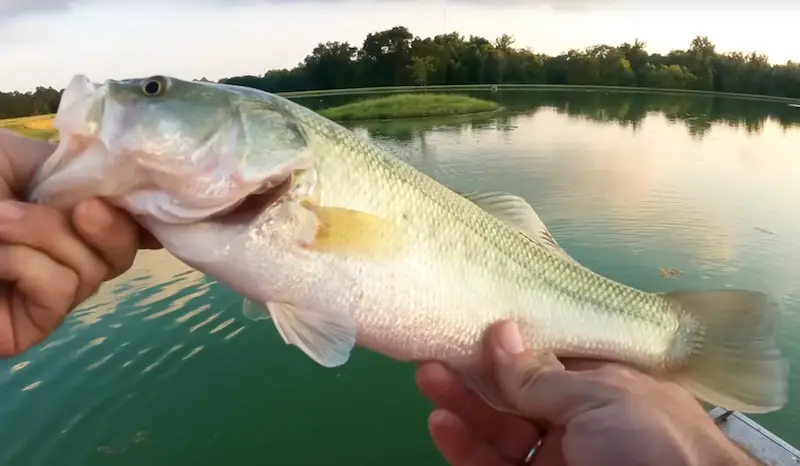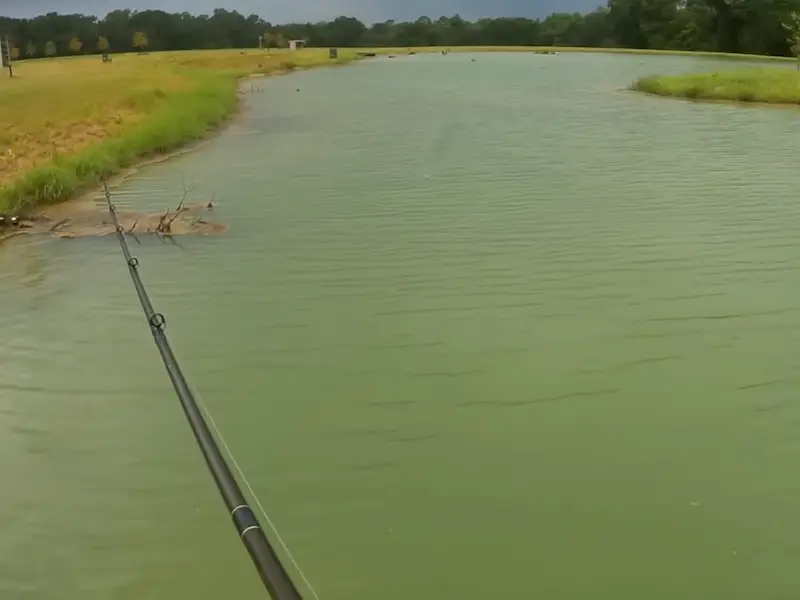Bank Fishing for Bass (Maximize Your Success from the Shore)
PUBLISHED 08 AUGUST 2023
by Robert Ceran
If you’re looking to catch bass without a boat, you’ll have to become good at bank fishing.
And while fishing from the shore is a lot easier to get started with than fishing with a bass boat, it also comes with several challenges that you’ll need to master if you don’t want to get skunked.
In this article I’ll share my best tips on how to catch more bass from the bank, ranging from lure recommendations to the most effective techniques I’ve refined over the years.

Lets dive in and master shore fishing!
Why bass fish from the bank?
Bank fishing provides an opportunity for anglers of all levels to enjoy bass fishing without breaking the budget.
Unlike boat fishing, which can be expensive and comes with a lot of costs bank fishing is highly accessible and affordable.
You don’t need to invest in a boat or expensive gear – all you require is your fishing equipment and a great spot along the shoreline.
Whether you’re an angler or just starting out bank fishing opens up a world of possibilities to experience the excitement of catching bass without spending a fortune.

Essential gear to catch bass from the bank
When engaging in bank fishing it’s important to focus on carrying the essential equipment that will enhance your fishing trips effectively.
Polarized sunglasses are an investment as they not only protect your eyes from the sun but also improve your visibility in the water making it easier to spot bass and potential structures.
Using a landing net can be a game changer especially when fishing from the shore with lots of rocks or debris. Look for a net with a sized hoop and long handle to extend your reach.
Invest in a fishing backpack or bag that allows you to carry all your essential equipment, including lures, pliers, fish scales and more.
Remember to prioritize sun protection during hours of fishing by using sunscreen wearing a wide brimmed hat and appropriate clothing to shield yourself from harmful rays.

Depending on where and when you’re fishing insect repellent can be incredibly useful against bugs. Lakeshores often have swarms of gnats and flies so having some repellent handy is highly recommended.
When space is limited and you lack fish finders or trolling motors it’s crucial not to waste time fishing, in areas without any fish. Focus on finding the spot instead.
How to find the best bank fishing spots for bass
When searching for bank fishing areas begin by seeking advice and insights from online resources such as fishing forums and social media groups.
Stay updated by checking out fishing reports provided by bait shops or government agencies as they offer real time information on the best places to catch bass.
Utilize tools like Google Maps and satellite imagery to examine spots with convenient access to the water. State and county parks often provide maintained areas that offer great fishing opportunities.
Additionally talking to locals can provide firsthand knowledge about the area while observing water conditions and natural structures like rocks and fallen trees is essential for ensuring safety.
Identifying ideal bass habitats
- Structure: Bass are naturally drawn to structures such as submerged rocks, fallen trees, docks or vegetation. These structures serve as both sheltered hideouts and strategic ambush points for targeting their prey.
- Water depth: The depth of the water plays a role in influencing bass behavior. In weather conditions they tend to stay in deeper waters where cooler temperatures can be found; however during colder months they may relocate to shallower areas closer to the surface in order to soak up sunlight and feed.
- Water temperature: Bass are highly responsive to changes, in water temperature. Bass tend to be more active and feed energetically in the optimal temperature range usually between 60°F to 75°F (15°C to 24°C).
- Cover: Look for areas with cover, like lily pads, grass or branches hanging over the water. These spots offer bass shade and a perfect hiding place to ambush their prey.
What’s the best time of day to bank fish for bass?
Early Morning; Dawn and the hours after sunrise are prime periods for bass fishing. During this time bass actively search for food after resting. Topwater lures and surface baits can be particularly effective as bass often strike with aggression at this time.
Late afternoon to evening; As the sun begins to set bass become more active again. They leave their hiding spots in pursuit of prey making this another excellent opportunity to target them. Casting along the shoreline or near structures can yield results during these hours.
Overcast days; On overcast days bass are more likely to roam and feed throughout the day due, to reduced sunlight making them feel less exposed.
To increase your chances of success try using lures and exploring various depths to locate where the bass are gathering.
When the weather is warm during spring and early summer bass tend to be more active and feed frequently. As the water temperature rises their metabolism increases well making them more willing to strike at different types of lures and baits.
Nighttime fishing can surprisingly yield results when fishing from the bank. Bass become braver during this time and venture into waters under the cover of darkness. To attract them during this period use colored lures and present them in a slow moving manner.
Best bank fishing lures and rigs for bass
When it comes to bank fishing having the right lures can make a significant difference in attracting those bass to bite. Here are some of the choices for bank fishing lures that every angler should have in their tackle box;
Soft plastic worms
These versatile and classic lures are essential for bank anglers. You can either Texas rig them or wacky rig them, or you can fish worms on a drop shot rig. With a little practice, these lifelike worms can imitate prey and entice bass bites in many situations.
Crankbaits
Ideal for covering water quickly and locating actively feeding bass, crankbaits come in different colors and sizes to match the water conditions and depths you’re fishing.
Spinnerbaits
Perfect for fishing around cover, spinnerbaits with their flashy blades and skirted bodies produce vibrations that catch the attention of bass prompting them to strike out of curiosity or aggression.
Topwater Lures
For a surface action experience bring along some topwater lures like poppers, buzzbaits and walking baits. There’s nothing, like witnessing a bass explode on a topwater lure!
Jigs
Jigs are incredibly versatile and highly effective when it comes to targeting bass around structures and areas with cover. You can enhance their effectiveness by pairing them with a trailer, such as an creature bait, which mimics the appearance of bottom dwelling prey like crawfish.
Swimbaits
Realistic swimbaits are a choice for imitating baitfish making them irresistible to bass. Try retrieving them or adding occasional twitches to mimic the movements of a wounded or fleeing fish. This will attract bass that’re on the lookout for an easy meal.
Every pond has its characteristics so don’t be afraid to experiment with different lures. Be adaptable. Find what works best for your local fishing spots. Armed with these top notch lures in your fishing arsenal you’ll be well prepared to tackle the waters from the shoreline and have a time catching some impressive bass!
Casting techniques for bank fishing
Mastering casting techniques can significantly elevate your bank fishing skills. Two popular methods that allow you to cover water and target specific areas effectively are fan casting and flipping and pitching.

Fan casting
Fan casting involves covering a wide area by casting your lure in a semi circular pattern. Start by casting ahead and then gradually move from left to right (or vice versa) exploring different angles as you retrieve the lure. This technique works wonders when you want to explore areas from the shoreline helping you locate scattered bass or those on the hunt, for prey.
Flipping and pitching
Flipping and pitching are more specialized casting techniques that require precision to target specific areas. These methods are especially useful when aiming for spots that are under vegetation, docks or submerged structures where bass tend to hide.
Flipping involves releasing your line and allowing your bait to descend towards the water while holding the line loosely between your thumb and forefinger. This controlled drop ensures an precise presentation.
Pitching is similar to flipping. Involves a more controlled cast. With your rod in one hand and the bait in the other swing your arm forward.
Release the bait towards the target with a flick of the wrist. This technique allows for distance and accuracy when casting to specific areas.
